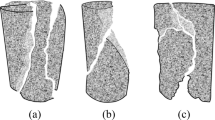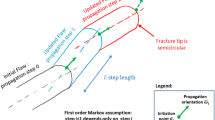Abstract
Heterogeneity and discontinuity significantly affect rock strength. For accurate stability prediction, intact rock behavior is imperatively included in rock mass behavior. However, past research largely used arbitrary scaling approaches to produce rock strength. This paper considers a stochastic approach in order to determine the strength of a rock. Based on the laboratory data, a MATLAB® with extreme value stochastic model generates a database for each physico-mechanical property. Then FLAC® simulates laboratory-sized rock specimens. The grids developed in the numerical model can in turn develop random material properties in MATLAB®, which researchers then applied to the final FLAC® model. Model runs simulate the approach performed in the laboratory. The results from the model indicate that a stochastic approach produces strengths that are lower than a deterministic approach. Failure modes for each specimen are different, similar to observations in the laboratory. In addition, random density also influences the failure mode, highlighting the importance of stochastic analysis in rocks.









Similar content being viewed by others
References
Mark C (1987) Analysis of longwall pillar stability. PhD Thesis. Pennsylvania State University
Bieniawski ZT (1968) The effect of specimen size on compressive strength of coal. Int J Rock Mech Min Sci Geomech Abstr 5(4):325–326
Recio-Gordo D, Jimenez R (2012) A probabilistic extension to the empirical ALPS and ARMPS systems for coal pillar design. Int J Rock Mech Min Sci 52:181–187
Soltani A (2015) Analysis of the ARMPS Database Using FLAC3D. University of Kentucky, A pillar stability comparison for room and pillar coal mines during development. Master’s Thesis
Jaksa MB, Kaggwa WS, Brooker PI (1999. Sydney) Experimental evaluation of the scale of fluctuation of a stiff clay. Proceedings of the 8th International Conference on the Application of Statistics and Probability 1:415–422
Fang Z, Harrison JP (2002) Development of a local degradation approach to the modelling of brittle fracture in heterogeneous rocks. Int J Rock Mech Min Sci 39(4):443–457
Kim K, Gao H (1995) Probabilistic approaches to estimating variation in the mechanical properties of rock masses. Int J Rock Mech Min Sci Geomech Abstr 32(2):111–120
Mingli H, Chunan T, Wancheng Z (2000) Numerical simulation on failure process of rock [J]. Chin J Rock Mech Eng 19(4):468–471
Deng J et al (2003) Pillar design by combining finite element methods, neural networks and reliability: a case study of the Feng Huangshan copper mine, China. Int J Rock Mech Min Sci 40(4):585–599
Jade S, Sitharam TG (2003) Characterization of strength and deformation of jointed rock mass based on statistical analysis. Int J Geomech 3(1):43–54
Itasca (2017) FLAC. https://www.itascacg.com/software/flac. Itasca Consulting Group, Inc. Minnesota, USA
Weibull W (1939) A statistical theory of the strength of materials. Ingeniors Vetenskaps Akademien
Einstein HH (1983) Probabilistic and statistical methods in engineering geology. Rock Mech Rock Eng 16(1):39–72
Potvin Y, Dight PM, Wesseloo J (2012) Some pitfalls and misuses of rock mass classification systems for mine design. J South Afr Inst Min Metall 112(8):697–702
Yegulalp TM, Kim K (1992) Statistical assessment of scale effect on rock properties using the theory of extremes. Transactions AIME 294:1834–1834
Gumbel EJ (2013) Statistics of extremes. Echo Point Books & Media, Brattleboro, VT
Hoek E, Brown ET (1980) Underground excavations in rock. CRC Press, Boca Raton, FL
MathWorks (2017) MATLAB®. https://www.mathworks.com/products/matlab.html. The Mathworks, Inc. Massachusetts, USA
Funding
This work was supported by the National Institute for Occupational Safety and Health [grant numbers 200-2011-40676, 200-2016-92214].
Author information
Authors and Affiliations
Corresponding author
Ethics declarations
Conflict of Interest
The authors declare that they have no conflict of interest.
Additional information
Publisher’s Note
Springer Nature remains neutral with regard to jurisdictional claims in published maps and institutional affiliations.
Rights and permissions
About this article
Cite this article
Gao, D., Mishra, B. & Xue, Y. Numerical Simulation of Laboratory Strength Tests Using a Stochastic Approach. Mining, Metallurgy & Exploration 37, 709–716 (2020). https://doi.org/10.1007/s42461-020-00189-7
Received:
Accepted:
Published:
Issue Date:
DOI: https://doi.org/10.1007/s42461-020-00189-7




